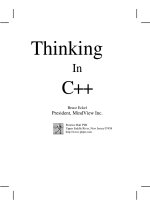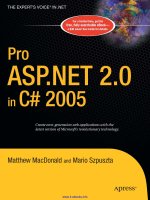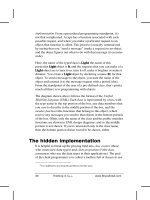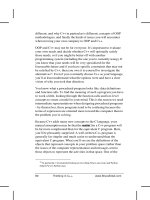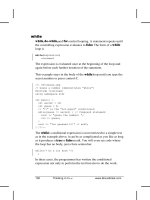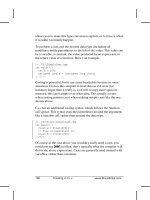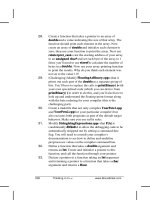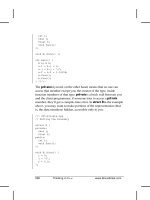Thinking in C plus plus (P15) pptx
Bạn đang xem bản rút gọn của tài liệu. Xem và tải ngay bản đầy đủ của tài liệu tại đây (177.07 KB, 50 trang )
680 Thinking in C++ www.BruceEckel.com
Instrument
is to create a common interface for all of the classes
derived from it.
Instrument
virtual void play()
virtual char* what()
virtual void adjust()
Wind
void play()
char* what()
void adjust()
Percussion
void play()
char* what()
void adjust()
Stringed
void play()
char* what()
void adjust()
Woodwind
void play()
char* what()
Brass
void play()
char* what()
The only reason to establish the common interface is so it can be
expressed differently for each different subtype. It creates a basic
form that determines what’s in common with all of the derived
classes – nothing else. So
Instrument
is an appropriate candidate to
be an abstract class. You create an abstract class when you only
want to manipulate a set of classes through a common interface,
but the common interface doesn’t need to have an implementation
(or at least, a full implementation).
If you have a concept like
Instrument
that works as an abstract
class, objects of that class almost always have no meaning. That is,
Instrument
is meant to express only the interface, and not a
15: Polymorphism & Virtual Functions 681
particular implementation, so creating an object that is only an
Instrument
makes no sense, and you’ll probably want to prevent
the user from doing it. This can be accomplished by making all the
virtual functions in
Instrument
print error messages, but that
delays the appearance of the error information until runtime and it
requires reliable exhaustive testing on the part of the user. It is
much better to catch the problem at compile time.
Here is the syntax used for a pure virtual declaration:
virtual void f() = 0;
By doing this, you tell the compiler to reserve a slot for a function
in the VTABLE, but not to put an address in that particular slot.
Even if only one function in a class is declared as pure virtual, the
VTABLE is incomplete.
If the VTABLE for a class is incomplete, what is the compiler
supposed to do when someone tries to make an object of that class?
It cannot safely create an object of an abstract class, so you get an
error message from the compiler. Thus, the compiler guarantees the
purity of the abstract class. By making a class abstract, you ensure
that the client programmer cannot misuse it.
Here’s
Instrument4.cpp
modified to use pure virtual functions.
Because the class has nothing but pure virtual functions, we call it a
pure abstract class
:
//: C15:Instrument5.cpp
// Pure abstract base classes
#include <iostream>
using namespace std;
enum note { middleC, Csharp, Cflat }; // Etc.
class Instrument {
public:
// Pure virtual functions:
virtual void play(note) const = 0;
virtual char* what() const = 0;
// Assume this will modify the object:
682 Thinking in C++ www.BruceEckel.com
virtual void adjust(int) = 0;
};
// Rest of the file is the same
class Wind : public Instrument {
public:
void play(note) const {
cout << "Wind::play" << endl;
}
char* what() const { return "Wind"; }
void adjust(int) {}
};
class Percussion : public Instrument {
public:
void play(note) const {
cout << "Percussion::play" << endl;
}
char* what() const { return "Percussion"; }
void adjust(int) {}
};
class Stringed : public Instrument {
public:
void play(note) const {
cout << "Stringed::play" << endl;
}
char* what() const { return "Stringed"; }
void adjust(int) {}
};
class Brass : public Wind {
public:
void play(note) const {
cout << "Brass::play" << endl;
}
char* what() const { return "Brass"; }
};
class Woodwind : public Wind {
public:
void play(note) const {
cout << "Woodwind::play" << endl;
}
char* what() const { return "Woodwind"; }
15: Polymorphism & Virtual Functions 683
};
// Identical function from before:
void tune(Instrument& i) {
//
i.play(middleC);
}
// New function:
void f(Instrument& i) { i.adjust(1); }
int main() {
Wind flute;
Percussion drum;
Stringed violin;
Brass flugelhorn;
Woodwind recorder;
tune(flute);
tune(drum);
tune(violin);
tune(flugelhorn);
tune(recorder);
f(flugelhorn);
} ///:~
Pure virtual functions are helpful because they make explicit the
abstractness of a class and tell both the user and the compiler how
it was intended to be used.
Note that pure virtual functions prevent an abstract class from
being passed into a function
by value
. Thus, it is also a way to
prevent
object slicing
(which will be described shortly). By making a
class abstract, you can ensure that a pointer or reference is always
used during upcasting to that class.
Just because one pure virtual function prevents the VTABLE from
being completed doesn’t mean that you don’t want function bodies
for some of the others. Often you will want to call a base-class
version of a function, even if it is virtual. It’s always a good idea to
put common code as close as possible to the root of your hierarchy.
684 Thinking in C++ www.BruceEckel.com
Not only does this save code space, it allows easy propagation of
changes.
Pure virtual definitions
It’s possible to provide a definition for a pure virtual function in the
base class. You’re still telling the compiler not to allow objects of
that abstract base class, and the pure virtual functions must still be
defined in derived classes in order to create objects. However, there
may be a common piece of code that you want some or all of the
derived class definitions to call rather than duplicating that code in
every function.
Here’s what a pure virtual definition looks like:
//: C15:PureVirtualDefinitions.cpp
// Pure virtual base definitions
#include <iostream>
using namespace std;
class Pet {
public:
virtual void speak() const = 0;
virtual void eat() const = 0;
// Inline pure virtual definitions illegal:
//! virtual void sleep() const = 0 {}
};
// OK, not defined inline
void Pet::eat() const {
cout << "Pet::eat()" << endl;
}
void Pet::speak() const {
cout << "Pet::speak()" << endl;
}
class Dog : public Pet {
public:
// Use the common Pet code:
void speak() const { Pet::speak(); }
void eat() const { Pet::eat(); }
15: Polymorphism & Virtual Functions 685
};
int main() {
Dog simba; // Richard's dog
simba.speak();
simba.eat();
} ///:~
The slot in the
Pet
VTABLE is still empty, but there happens to be a
function by that name that you can call in the derived class.
The other benefit to this feature is that it allows you to change from
an ordinary virtual to a pure virtual without disturbing the existing
code. (This is a way for you to locate classes that don’t override that
virtual function.)
Inheritance and the VTABLE
You can imagine what happens when you perform inheritance and
override some of the virtual functions. The compiler creates a new
VTABLE for your new class, and it inserts your new function
addresses using the base-class function addresses for any virtual
functions you don’t override. One way or another, for every object
that can be created (that is, its class has no pure virtuals) there’s
always a full set of function addresses in the VTABLE, so you’ll
never be able to make a call to an address that isn’t there (which
would be disastrous).
But what happens when you inherit and add new virtual functions
in the
derived
class? Here’s a simple example:
//: C15:AddingVirtuals.cpp
// Adding virtuals in derivation
#include <iostream>
#include <string>
using namespace std;
class Pet {
string pname;
public:
686 Thinking in C++ www.BruceEckel.com
Pet(const string& petName) : pname(petName) {}
virtual string name() const { return pname; }
virtual string speak() const { return ""; }
};
class Dog : public Pet {
string name;
public:
Dog(const string& petName) : Pet(petName) {}
// New virtual function in the Dog class:
virtual string sit() const {
return Pet::name() + " sits";
}
string speak() const { // Override
return Pet::name() + " says 'Bark!'";
}
};
int main() {
Pet* p[] = {new Pet("generic"),new Dog("bob")};
cout << "p[0]->speak() = "
<< p[0]->speak() << endl;
cout << "p[1]->speak() = "
<< p[1]->speak() << endl;
//! cout << "p[1]->sit() = "
//! << p[1]->sit() << endl; // Illegal
} ///:~
The class
Pet
contains a two virtual functions:
speak( )
and
name( )
.
Dog
adds a third virtual function called
sit( )
, as well as overriding
the meaning of
speak( )
. A diagram will help you visualize what’s
happening. Here are the VTABLEs created by the compiler for
Pet
and
Dog
:
&Pet::name
&Pet::speak
&Pet::name
&Dog::speak
&Dog::sit
15: Polymorphism & Virtual Functions 687
Notice that the compiler maps the location of the
speak( )
address
into exactly the same spot in the
Dog
VTABLE as it is in the
Pet
VTABLE. Similarly, if a class
Pug
is inherited from
Dog
, its version
of
sit( )
would be placed in its VTABLE in exactly the same spot as
it is in
Dog
. This is because (as you saw with the assembly-
language example) the compiler generates code that uses a simple
numerical offset into the VTABLE to select the virtual function.
Regardless of the specific subtype the object belongs to, its VTABLE
is laid out the same way, so calls to the virtual functions will
always be made the same way.
In this case, however, the compiler is working only with a pointer
to a base-class object. The base class has only the
speak( )
and
name( )
functions, so those is the only functions the compiler will
allow you to call. How could it possibly know that you are working
with a
Dog
object, if it has only a pointer to a base-class object?
That pointer might point to some other type, which doesn’t have a
sit( )
function. It may or may not have some other function address
at that point in the VTABLE, but in either case, making a virtual call
to that VTABLE address is not what you want to do. So the
compiler is doing its job by protecting you from making virtual
calls to functions that exist only in derived classes.
There are some less-common cases in which you may know that the
pointer actually points to an object of a specific subclass. If you
want to call a function that only exists in that subclass, then you
must cast the pointer. You can remove the error message produced
by the previous program like this:
((Dog*)p[1])->sit()
Here, you happen to know that
p[1]
points to a
Dog
object, but in
general you don’t know that. If your problem is set up so that you
must know the exact types of all objects, you should rethink it,
because you’re probably not using virtual functions properly.
However, there are some situations in which the design works best
(or you have no choice) if you know the exact type of all objects
688 Thinking in C++ www.BruceEckel.com
kept in a generic container. This is the problem of
run-time type
identification
(RTTI)
.
RTTI is all about casting base-class pointers
down
to derived-class
pointers (“up” and “down” are relative to a typical class diagram,
with the base class at the top). Casting
up
happens automatically,
with no coercion, because it’s completely safe. Casting
down
is
unsafe because there’s no compile time information about the
actual types, so you must know exactly what type the object is. If
you cast it into the wrong type, you’ll be in trouble.
RTTI is described later in this chapter, and Volume 2 of this book
has a chapter devoted to the subject.
Object slicing
There is a distinct difference between passing the addresses of
objects and passing objects by value when using polymorphism.
All the examples you’ve seen here, and virtually all the examples
you should see, pass addresses and not values. This is because
addresses all have the same size
5
, so passing the address of an
object of a derived type (which is usually a bigger object) is the
same as passing the address of an object of the base type (which is
usually a smaller object). As explained before, this is the goal when
using polymorphism – code that manipulates a base type can
transparently manipulate derived-type objects as well.
If you upcast to an object instead of a pointer or reference,
something will happen that may surprise you: the object is “sliced”
until all that remains is the subobject that corresponds to the
destination type of your cast. In the following example you can see
what happens when an object is sliced:
//: C15:ObjectSlicing.cpp
5
Actually, not all pointers are the same size on all machines. In the context of this
discussion, however, they can be considered to be the same.
15: Polymorphism & Virtual Functions 689
#include <iostream>
#include <string>
using namespace std;
class Pet {
string pname;
public:
Pet(const string& name) : pname(name) {}
virtual string name() const { return pname; }
virtual string description() const {
return "This is " + pname;
}
};
class Dog : public Pet {
string favoriteActivity;
public:
Dog(const string& name, const string& activity)
: Pet(name), favoriteActivity(activity) {}
string description() const {
return Pet::name() + " likes to " +
favoriteActivity;
}
};
void describe(Pet p) { // Slices the object
cout << p.description() << endl;
}
int main() {
Pet p("Alfred");
Dog d("Fluffy", "sleep");
describe(p);
describe(d);
} ///:~
The function
describe( )
is passed an object of type
Pet
by value
. It
then calls the virtual function
description( )
for the
Pet
object. In
main( )
, you might expect the first call to produce “This is Alfred,”
and the second to produce “Fluffy likes to sleep.” In fact, both calls
use the base-class version of
description( )
.
690 Thinking in C++ www.BruceEckel.com
Two things are happening in this program. First, because
describe( )
accepts a
Pet
object
(rather than a pointer or reference),
any calls to
describe( )
will cause an object the size of
Pet
to be
pushed on the stack and cleaned up after the call. This means that if
an object of a class inherited from
Pet
is passed to
describe( )
, the
compiler accepts it, but it copies only the
Pet
portion of the object.
It
slices
the derived portion off of the object, like this:
favoriteActivity
Dog vptr
pname
Pet vptr
pname
Before Slice After Slice
Now you may wonder about the virtual function call.
Dog::description( )
makes use of portions of both
Pet
(which still
exists) and
Dog
, which no longer exists because it was sliced off! So
what happens when the virtual function is called?
You’re saved from disaster because the object is being passed by
value. Because of this, the compiler knows the precise type of the
object because the derived object has been forced to become a base
object. When passing by value, the copy-constructor for a
Pet
object
is used, which initializes the VPTR to the
Pet
VTABLE and copies
only the
Pet
parts of the object. There’s no explicit copy-constructor
here, so the compiler synthesizes one. Under all interpretations, the
object truly becomes a
Pet
during slicing.
Object slicing actually removes part of the existing object as it
copies it into the new object, rather than simply changing the
meaning of an address as when using a pointer or reference.
Because of this, upcasting into an object is not done often; in fact,
it’s usually something to watch out for and prevent. Note that, in
this example, if
description( )
were made into a pure virtual
function in the base class (which is not unreasonable, since it
15: Polymorphism & Virtual Functions 691
doesn’t really do anything in the base class), then the compiler
would prevent object slicing because that wouldn’t allow you to
“create” an object of the base type (which is what happens when
you upcast by value). This could be the most important value of
pure virtual functions: to prevent object slicing by generating a
compile-time error message if someone tries to do it.
Overloading & overriding
In Chapter 14, you saw that redefining an overloaded function in
the base class hides all of the other base-class versions of that
function. When
virtual
functions are involved the behavior is a
little different. Consider a modified version of the
NameHiding.cpp
example from Chapter 14:
//: C15:NameHiding2.cpp
// Virtual functions restrict overloading
#include <iostream>
#include <string>
using namespace std;
class Base {
public:
virtual int f() const {
cout << "Base::f()\n";
return 1;
}
virtual void f(string) const {}
virtual void g() const {}
};
class Derived1 : public Base {
public:
void g() const {}
};
class Derived2 : public Base {
public:
// Overriding a virtual function:
int f() const {
cout << "Derived2::f()\n";
692 Thinking in C++ www.BruceEckel.com
return 2;
}
};
class Derived3 : public Base {
public:
// Cannot change return type:
//! void f() const{ cout << "Derived3::f()\n";}
};
class Derived4 : public Base {
public:
// Change argument list:
int f(int) const {
cout << "Derived4::f()\n";
return 4;
}
};
int main() {
string s("hello");
Derived1 d1;
int x = d1.f();
d1.f(s);
Derived2 d2;
x = d2.f();
//! d2.f(s); // string version hidden
Derived4 d4;
x = d4.f(1);
//! x = d4.f(); // f() version hidden
//! d4.f(s); // string version hidden
Base& br = d4; // Upcast
//! br.f(1); // Derived version unavailable
br.f(); // Base version available
br.f(s); // Base version abailable
} ///:~
The first thing to notice is that in
Derived3
, the compiler will not
allow you to change the return type of an overridden function (it
will allow it if
f( )
is not virtual). This is an important restriction
because the compiler must guarantee that you can polymorphically
call the function through the base class, and if the base class is
15: Polymorphism & Virtual Functions 693
expecting an
int
to be returned from
f( )
, then the derived-class
version of
f( )
must keep that contract or else things will break.
The rule shown in Chapter 14 still works: if you override one of the
overloaded member functions in the base class, the other
overloaded versions become hidden in the derived class. In
main( )
the code that tests
Derived4
shows that this happens even if the
new version of
f( )
isn’t actually overriding an existing virtual
function interface – both of the base-class versions of
f( )
are hidden
by
f(int)
. However, if you upcast
d4
to
Base
, then only the base-
class versions are available (because that’s what the base-class
contract promises) and the derived-class version is not available
(because it isn’t specified in the base class).
Variant return type
The
Derived3
class above suggests that you cannot modify the
return type of a virtual function during overriding. This is
generally true, but there is a special case in which you can slightly
modify the return type. If you’re returning a pointer or a reference
to a base class, then the overridden version of the function may
return a pointer or reference to a class derived from what the base
returns. For example:
//: C15:VariantReturn.cpp
// Returning a pointer or reference to a derived
// type during ovverriding
#include <iostream>
#include <string>
using namespace std;
class PetFood {
public:
virtual string foodType() const = 0;
};
class Pet {
public:
virtual string type() const = 0;
virtual PetFood* eats() = 0;
694 Thinking in C++ www.BruceEckel.com
};
class Bird : public Pet {
public:
string type() const { return "Bird"; }
class BirdFood : public PetFood {
public:
string foodType() const {
return "Bird food";
}
};
// Upcast to base type:
PetFood* eats() { return &bf; }
private:
BirdFood bf;
};
class Cat : public Pet {
public:
string type() const { return "Cat"; }
class CatFood : public PetFood {
public:
string foodType() const { return "Birds"; }
};
// Return exact type instead:
CatFood* eats() { return &cf; }
private:
CatFood cf;
};
int main() {
Bird b;
Cat c;
Pet* p[] = { &b, &c, };
for(int i = 0; i < sizeof p / sizeof *p; i++)
cout << p[i]->type() << " eats "
<< p[i]->eats()->foodType() << endl;
// Can return the exact type:
Cat::CatFood* cf = c.eats();
Bird::BirdFood* bf;
// Cannot return the exact type:
//! bf = b.eats();
// Must downcast:
bf = dynamic_cast<Bird::BirdFood*>(b.eats());
} ///:~
15: Polymorphism & Virtual Functions 695
The
Pet::eats( )
member function returns a pointer to a
PetFood
. In
Bird
, this member function is overloaded exactly as in the base
class, including the return type. That is,
Bird::eats( )
upcasts the
BirdFood
to a
PetFood
.
But in
Cat
, the return type of
eats( )
is a pointer to
CatFood
, a type
derived from
PetFood
. The fact that the return type is inherited
from the return type of the base-class function is the only reason
this compiles. That way, the contract is still fulfilled;
eats( )
always
returns a
PetFood
pointer.
If you think polymorphically, this doesn’t seem necessary. Why not
just upcast all the return types to
PetFood*
, just as
Bird::eats( )
did?
This is typically a good solution, but at the end of
main( )
, you see
the difference:
Cat::eats( )
can return the exact type of
PetFood
,
whereas the return value of
Bird::eats( )
must be downcast to the
exact type.
So being able to return the exact type is a little more general, and
doesn’t lose the specific type information by automatically
upcasting. However, returning the base type will generally solve
your problems so this is a rather specialized feature.
virtual functions & constructors
When an object containing virtual functions is created, its VPTR
must be initialized to point to the proper VTABLE. This must be
done before there’s any possibility of calling a virtual function. As
you might guess, because the constructor has the job of bringing an
object into existence, it is also the constructor’s job to set up the
VPTR. The compiler secretly inserts code into the beginning of the
constructor that initializes the VPTR. And as described in Chapter
14, if you don’t explicitly create a constructor for a class, the
compiler will synthesize one for you. If the class has virtual
functions, the synthesized constructor will include the proper
VPTR initialization code. This has several implications.
696 Thinking in C++ www.BruceEckel.com
The first concerns efficiency. The reason for
inline
functions is to
reduce the calling overhead for small functions. If C++ didn’t
provide
inline
functions, the preprocessor might be used to create
these “macros.” However, the preprocessor has no concept of
access or classes, and therefore couldn’t be used to create member
function macros. In addition, with constructors that must have
hidden code inserted by the compiler, a preprocessor macro
wouldn’t work at all.
You must be aware when hunting for efficiency holes that the
compiler is inserting hidden code into your constructor function.
Not only must it initialize the VPTR, it must also check the value of
this
(in case the
operator
new
returns zero) and call base-class
constructors. Taken together, this code can impact what you
thought was a tiny inline function call. In particular, the size of the
constructor may overwhelm the savings you get from reduced
function-call overhead. If you make a lot of inline constructor calls,
your code size can grow without any benefits in speed.
Of course, you probably won’t make all tiny constructors non-
inline right away, because they’re much easier to write as inlines.
But when you’re tuning your code, remember to consider removing
the inline constructors.
Order of constructor calls
The second interesting facet of constructors and virtual functions
concerns the order of constructor calls and the way virtual calls are
made within constructors.
All base-class constructors are always called in the constructor for
an inherited class. This makes sense because the constructor has a
special job: to see that the object is built properly. A derived class
has access only to its own members, and not those of the base class.
Only the base-class constructor can properly initialize its own
elements. Therefore it’s essential that all constructors get called;
otherwise the entire object wouldn’t be constructed properly. That’s
15: Polymorphism & Virtual Functions 697
why the compiler enforces a constructor call for every portion of a
derived class. It will call the default constructor if you don’t
explicitly call a base-class constructor in the constructor initializer
list. If there is no default constructor, the compiler will complain.
The order of the constructor calls is important. When you inherit,
you know all about the base class and can access any
public
and
protected
members of the base class. This means you must be able
to assume that all the members of the base class are valid when
you’re in the derived class. In a normal member function,
construction has already taken place, so all the members of all parts
of the object have been built. Inside the constructor, however, you
must be able to assume that all members that you use have been
built. The only way to guarantee this is for the base-class
constructor to be called first. Then when you’re in the derived-class
constructor, all the members you can access in the base class have
been initialized. “Knowing all members are valid” inside the
constructor is also the reason that, whenever possible, you should
initialize all member objects (that is, objects placed in the class
using composition) in the constructor initializer list. If you follow
this practice, you can assume that all base class members
and
member objects of the current object have been initialized.
Behavior of virtual functions inside
constructors
The hierarchy of constructor calls brings up an interesting
dilemma. What happens if you’re inside a constructor and you call
a virtual function? Inside an ordinary member function you can
imagine what will happen – the virtual call is resolved at runtime
because the object cannot know whether it belongs to the class the
member function is in, or some class derived from it. For
consistency, you might think this is what should happen inside
constructors.
698 Thinking in C++ www.BruceEckel.com
This is not the case. If you call a virtual function inside a
constructor, only the local version of the function is used. That is,
the virtual mechanism doesn’t work within the constructor.
This behavior makes sense for two reasons. Conceptually, the
constructor’s job is to bring the object into existence (which is
hardly an ordinary feat). Inside any constructor, the object may
only be partially formed – you can only know that the base-class
objects have been initialized, but you cannot know which classes
are inherited from you. A virtual function call, however, reaches
“forward” or “outward” into the inheritance hierarchy. It calls a
function in a derived class. If you could do this inside a constructor,
you’d be calling a function that might manipulate members that
hadn’t been initialized yet, a sure recipe for disaster.
The second reason is a mechanical one. When a constructor is
called, one of the first things it does is initialize its VPTR. However,
it can only know that it is of the “current” type – the type the
constructor was written for. The constructor code is completely
ignorant of whether or not the object is in the base of another class.
When the compiler generates code for that constructor, it generates
code for a constructor of that class, not a base class and not a class
derived from it (because a class can’t know who inherits it). So the
VPTR it uses must be for the VTABLE of
that
class. The VPTR
remains initialized to that VTABLE for the rest of the object’s
lifetime
unless
this isn’t the last constructor call. If a more-derived
constructor is called afterwards, that constructor sets the VPTR to
its
VTABLE, and so on, until the last constructor finishes. The state
of the VPTR is determined by the constructor that is called last.
This is another reason why the constructors are called in order from
base to most-derived.
But while all this series of constructor calls is taking place, each
constructor has set the VPTR to its own VTABLE. If it uses the
virtual mechanism for function calls, it will produce only a call
through its own VTABLE, not the most-derived VTABLE (as would
15: Polymorphism & Virtual Functions 699
be the case after
all
the constructors were called). In addition, many
compilers recognize that a virtual function call is being made inside
a constructor, and perform early binding because they know that
late-binding will produce a call only to the local function. In either
event, you won’t get the results you might initially expect from a
virtual function call inside a constructor.
Destructors and virtual destructors
You cannot use the
virtual
keyword with constructors, but
destructors can and often must be virtual.
The constructor has the special job of putting an object together
piece-by-piece, first by calling the base constructor, then the more
derived constructors in order of inheritance (it must also call
member-object constructors along the way). Similarly, the
destructor has a special job: it must disassemble an object that may
belong to a hierarchy of classes. To do this, the compiler generates
code that calls all the destructors, but in the
reverse
order that they
are called by the constructor. That is, the destructor starts at the
most-derived class and works its way down to the base class. This
is the safe and desirable thing to do because the current destructor
can always know that the base-class members are alive and active.
If you need to call a base-class member function inside your
destructor, it is safe to do so. Thus, the destructor can perform its
own cleanup, then call the next-down destructor, which will
perform
its
own cleanup, etc. Each destructor knows what its class
is derived
from
, but not what is derived from it.
You should keep in mind that constructors and destructors are the
only places where this hierarchy of calls must happen (and thus the
proper hierarchy is automatically generated by the compiler). In all
other functions, only
that
function will be called (and not base-class
versions), whether it’s virtual or not. The only way for base-class
versions of the same function to be called in ordinary functions
(virtual or not) is if you
explicitly
call that function.
700 Thinking in C++ www.BruceEckel.com
Normally, the action of the destructor is quite adequate. But what
happens if you want to manipulate an object through a pointer to
its base class (that is, manipulate the object through its generic
interface)? This activity is a major objective in object-oriented
programming. The problem occurs when you want to
delete
a
pointer of this type for an object that has been created on the heap
with
new
. If the pointer is to the base class, the compiler can only
know to call the base-class version of the destructor during
delete
.
Sound familiar? This is the same problem that virtual functions
were created to solve for the general case. Fortunately, virtual
functions work for destructors as they do for all other functions
except constructors.
//: C15:VirtualDestructors.cpp
// Behavior of virtual vs. non-virtual destructor
#include <iostream>
using namespace std;
class Base1 {
public:
~Base1() { cout << "~Base1()\n"; }
};
class Derived1 : public Base1 {
public:
~Derived1() { cout << "~Derived1()\n"; }
};
class Base2 {
public:
virtual ~Base2() { cout << "~Base2()\n"; }
};
class Derived2 : public Base2 {
public:
~Derived2() { cout << "~Derived2()\n"; }
};
int main() {
Base1* bp = new Derived1; // Upcast
delete bp;
Base2* b2p = new Derived2; // Upcast
15: Polymorphism & Virtual Functions 701
delete b2p;
} ///:~
When you run the program, you’ll see that
delete bp
only calls the
base-class destructor, while
delete b2p
calls the derived-class
destructor followed by the base-class destructor, which is the
behavior we desire. Forgetting to make a destructor
virtual
is an
insidious bug because it often doesn’t directly affect the behavior of
your program, but it can quietly introduce a memory leak. Also, the
fact that
some
destruction is occurring can further mask the
problem.
Even though the destructor, like the constructor, is an
“exceptional” function, it is possible for the destructor to be virtual
because the object already knows what type it is (whereas it doesn’t
during construction). Once an object has been constructed, its
VPTR is initialized, so virtual function calls can take place.
Pure virtual destructors
While pure virtual destructors are legal in Standard C++, there is
an added constraint when using them: you must provide a function
body for the pure virtual destructor. This seems counterintuitive;
how can a virtual function be “pure” if it needs a function body?
But if you keep in mind that constructors and destructors are
special operations it makes more sense, especially if you remember
that all destructors in a class hierarchy are always called. If you
could
leave off the definition for a pure virtual destructor, what
function body would be called during destruction? Thus, it’s
absolutely necessary that the compiler and linker enforce the
existence of a function body for a pure virtual destructor.
If it’s pure, but it has to have a function body, what’s the value of
it? The only difference you’ll see between the pure and non-pure
virtual destructor is that the pure virtual destructor does cause the
base class to be abstract, so you cannot create an object of the base
702 Thinking in C++ www.BruceEckel.com
class (although this would also be true if any other member
function of the base class were pure virtual).
Things are a bit confusing, however, when you inherit a class from
one that contains a pure virtual destructor. Unlike every other pure
virtual function, you are
not
required to provide a definition of a
pure virtual destructor in the derived class. The fact that the
following compiles and links is the proof:
//: C15:UnAbstract.cpp
// Pure virtual destructors
// seem to behave strangely
class AbstractBase {
public:
virtual ~AbstractBase() = 0;
};
AbstractBase::~AbstractBase() {}
class Derived : public AbstractBase {};
// No overriding of destructor necessary?
int main() { Derived d; } ///:~
Normally, a pure virtual function in a base class would cause the
derived class to be abstract unless it (and all other pure virtual
functions) is given a definition. But here, this seems not to be the
case. However, remember that the compiler
automatically
creates a
destructor definition for every class if you don’t create one. That’s
what’s happening here – the base class destructor is being quietly
overridden, and thus the definition is being provided by the
compiler and
Derived
is not actually abstract.
This brings up an interesting question: What is the point of a pure
virtual destructor? Unlike an ordinary pure virtual function, you
must
give it a function body. In a derived class, you aren’t forced to
provide a definition since the compiler synthesizes the destructor
for you. So what’s the difference between a regular virtual
destructor and a pure virtual destructor?
15: Polymorphism & Virtual Functions 703
The only distinction occurs when you have a class that only has a
single pure virtual function: the destructor. In this case, the only
effect of the purity of the destructor is to prevent the instantiation
of the base class. If there were any other pure virtual functions,
they would prevent the instantiation of the base class, but if there
are no others, then the pure virtual destructor will do it. So, while
the addition of a virtual destructor is essential, whether it’s pure or
not isn’t so important.
When you run the following example, you can see that the pure
virtual function body is called after the derived class version, just
as with any other destructor:
//: C15:PureVirtualDestructors.cpp
// Pure virtual destructors
// require a function body
#include <iostream>
using namespace std;
class Pet {
public:
virtual ~Pet() = 0;
};
Pet::~Pet() {
cout << "~Pet()" << endl;
}
class Dog : public Pet {
public:
~Dog() {
cout << "~Dog()" << endl;
}
};
int main() {
Pet* p = new Dog; // Upcast
delete p; // Virtual destructor call
} ///:~
704 Thinking in C++ www.BruceEckel.com
As a guideline, any time you have a virtual function in a class, you
should immediately add a virtual destructor (even if it does
nothing). This way, you ensure against any surprises later.
Virtuals in destructors
There’s something that happens during destruction that you might
not immediately expect. If you’re inside an ordinary member
function and you call a virtual function, that function is called
using the late-binding mechanism. This is not true with destructors,
virtual or not. Inside a destructor, only the “local” version of the
member function is called; the virtual mechanism is ignored.
//: C15:VirtualsInDestructors.cpp
// Virtual calls inside destructors
#include <iostream>
using namespace std;
class Base {
public:
virtual ~Base() {
cout << "Base1()\n";
f();
}
virtual void f() { cout << "Base::f()\n"; }
};
class Derived : public Base {
public:
~Derived() { cout << "~Derived()\n"; }
void f() { cout << "Derived::f()\n"; }
};
int main() {
Base* bp = new Derived; // Upcast
delete bp;
} ///:~
During the destructor call,
Derived::f( )
is
not
called, even though
f( )
is virtual.
